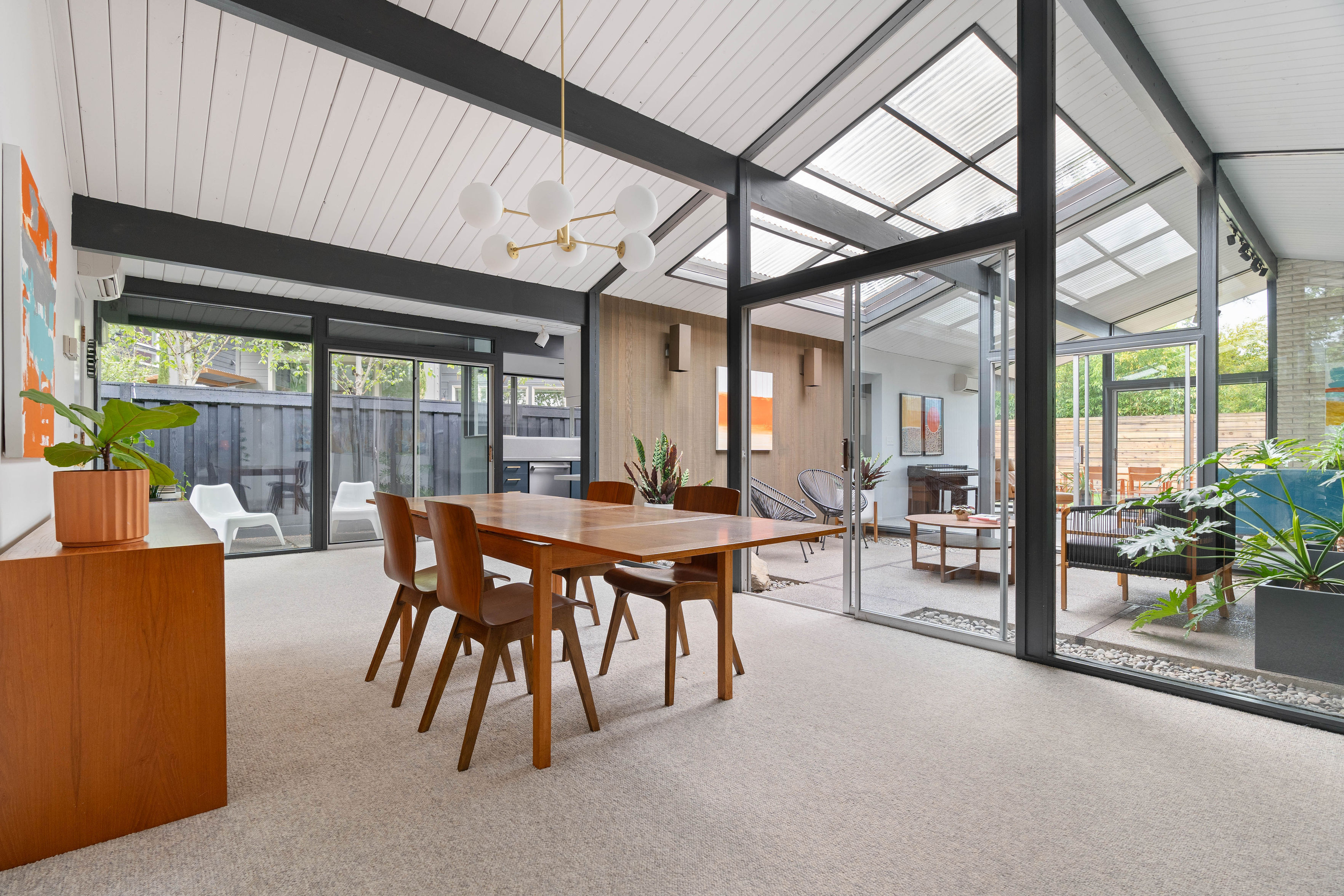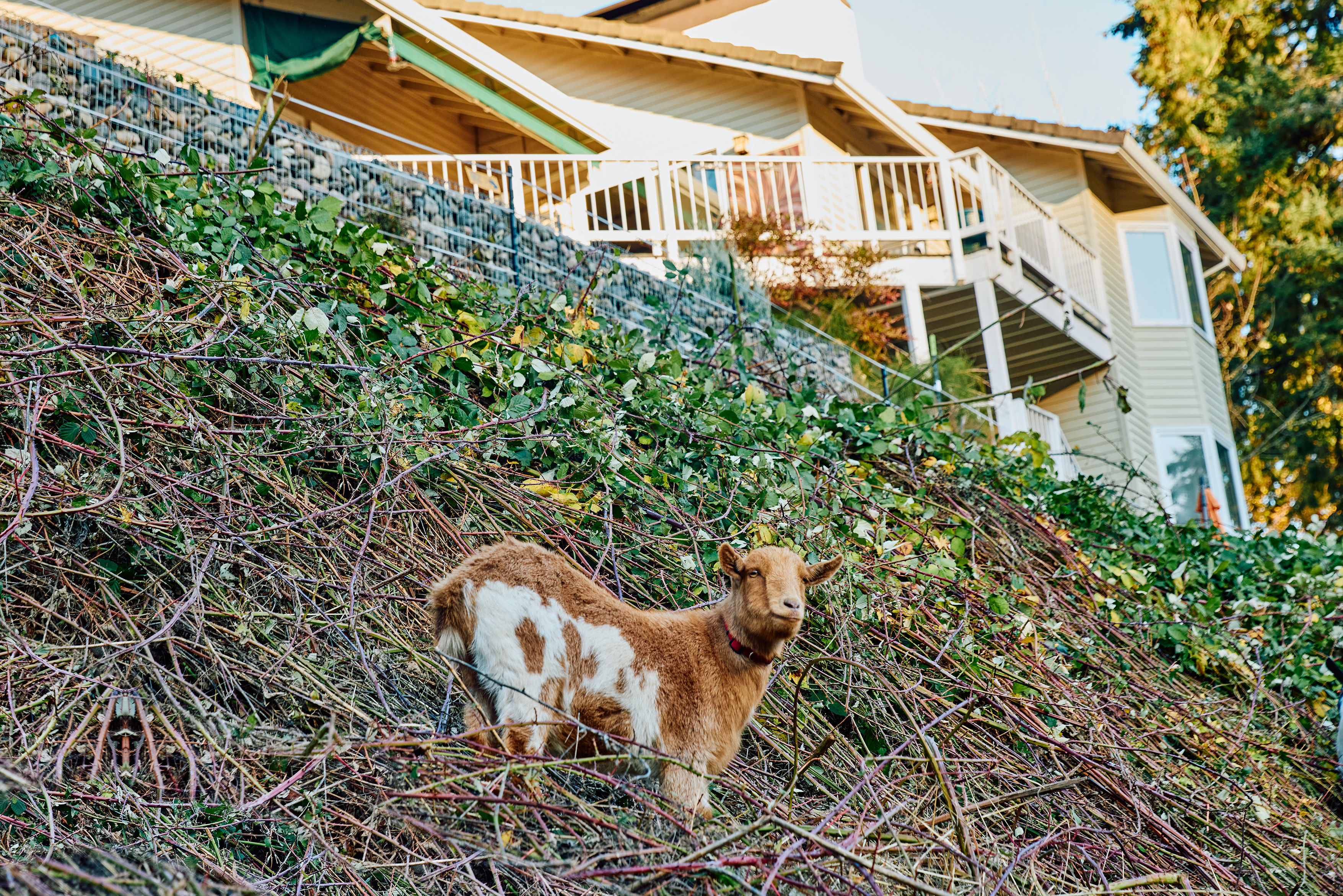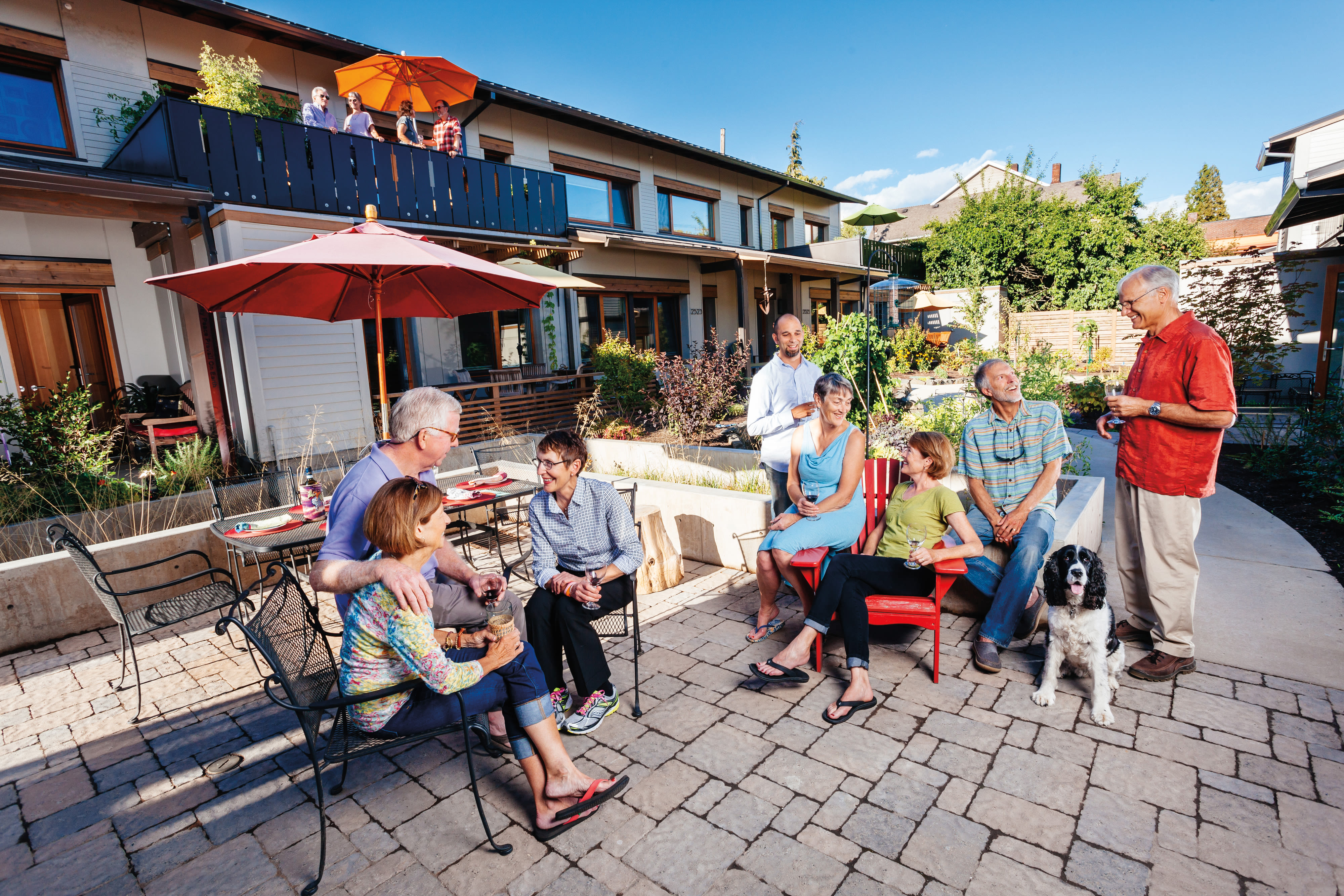
How a Bunch of Retirees Created Portland's Greenest Communal Housing Outpost
At first glance, the new “pocket” neighborhood Ankeny Row feels like Portland’s version of Melrose Place. Quick hellos between Row members easily stretch out to glasses of wine and public-policy debates on the communal patio—a space lined with concrete troughs of sea grass and tepees of curling green beans. An Aussie shepherd mix named Kayla snoozes in the sun in front of the small cluster of broad-beamed contemporary craftsman townhouses. Hectic East Burnside is only a block away, but the ring of two-story homes acts as a sound dampener, and traffic is no more than an oceanic murmur.
Turns out, a bunch of retired city planners and lawyers have dreamed up one of the city’s most ambitious, unorthodox living arrangements: a cohousing community that sits at the nexus of the city’s density issues, the aging-in-place movement, and sustainable design. Indeed, Ankeny Row is so efficient you could practically run each home with the juice it takes to power a hairdryer.
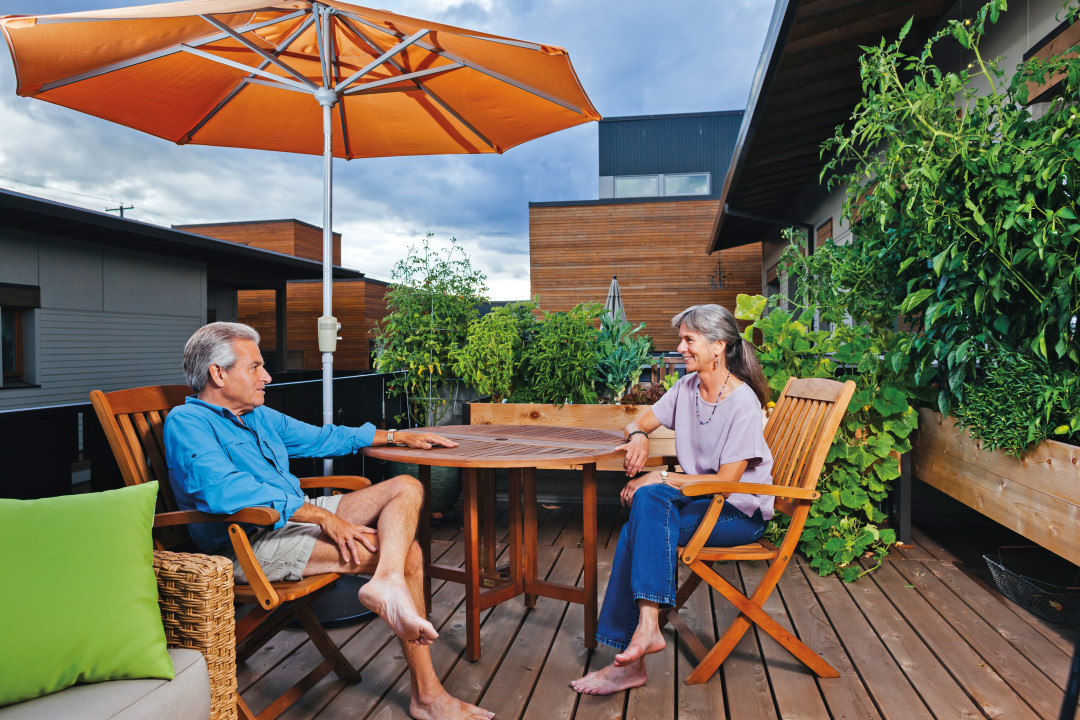
David Siegel and Lainie Smith on their second-floor deck.
Image: Jason Quigley
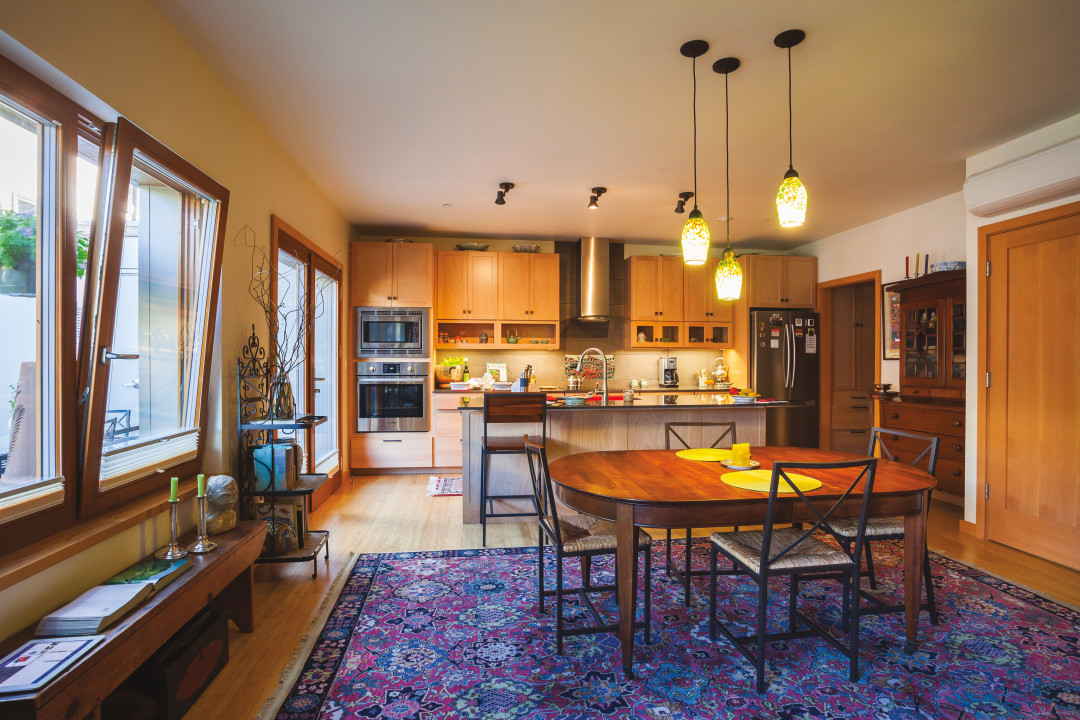
Tilt-and-turn windows manage airflow throughout Ankeny Row.
Image: Jason Quigley
“I like living in a community of friends, being able to bike or walk to the grocery store,” says Ankeny Row cofounder Francie Royce. “And I love getting a zero-kilowatt electric bill.”
Royce, 67, a former City of Portland planner, and her husband, Michael, 68, had tossed around the idea of cohousing with longtime friends Richard Benner and Lavinia Gordon for years. The quartet also wanted to harness the spirit of Michael’s nonprofit Green Empowerment, which helps villages around the globe access clean water and renewable energy. In 2010, their vision became a leap of faith: They pooled their resources and bought a derelict warehouse on a 12,000-square-foot plot in Southeast Portland.
Although the Ankeny group was committed to building a green community, they had little idea how to do it. Enter local design-build outfit Green Hammer, a cadre of “architecture and energy geeks” led by Stephen Aiguier, an active outdoorsman with a near-evangelical devotion to green standards. “Other firms tried to talk us down [from our sustainability goals], but Green Hammer went further than we expected,” says Francie.
“Further” included inducting future residents to the cult of the passive house, a hard-core design standard that cranks sustainability goals to 11, tapping superinsulated, airtight construction and a suite of interconnected systems—from heat-recovery ventilation to solar panels—to max out energy efficiencies and healthy airflow. Ankeny Row’s homes would have just 30 percent of the carbon footprint of typical new houses. Their passive homes will be strong enough to be passed down to their grandchildren decades from now.
Francie and her friends were sold, and their excitement lured four more couples, including former coworkers David Siegel and Lainie Smith, to buy into the development at around $750,000 for each three-bedroom, two-bath unit. “I worked with Francie and Lavinia in the ’90s,” marvels Siegel. “Who knew we’d all move in together?”
Ankeny Row broke ground in 2013, transforming the brownfield lot into a flower-bedecked hamlet of six homes and a shared common building. While each light-filled townhouse has a similar, wheelchair-friendly layout, each is also a reflection of its owners. The Royces’ exposed-beam living room is decorated with mementos from their trips around the globe, while Siegel and Smith’s digs sport Doug fir cabinets, a 40-year-old turtle, and a guitar collection.
It’s not perfect: Royce says it took a while to learn how to operate the complicated ventilation system, and the kitchens’ induction stove came with a learning curve. (“It’s pretty Star Wars-y,” jokes Siegel.) Aiguier often stops by to act as the Row’s green-energy conscience, reminding residents to shut their windows when it gets hot outside and practice their “night flush” (see p. 86).
Overall, though, the neighbors are blissed out in their lean, green village. “It’s comfy, it’s quiet, and the neighborhood is way cool,” says Siegel, standing in the courtyard with Aiguier. “To me, it’s about community. We’ve got each others’ backs.”
“That’s what we could have had here,” Aiguier says, pointing to the hulking form of a traditional high-rise apartment complex under construction just blocks away from Ankeny Row. “Nobody is doing this except a few brave individuals,” he continues, spreading his arms to encompass the whole cohousing village. “They shot the moon on their values. It’s awesome.”
HOW TO LIVE THE GREEN DREAM
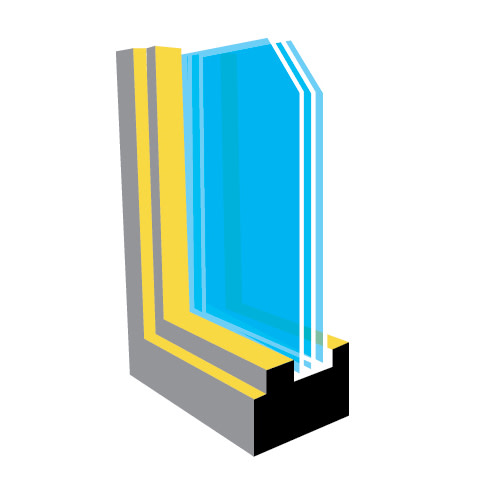
Image: Michael Novak
ZOLA WINDOWS
These Polish-made, triple-paned “tilt-and-turn” windows are chic airlocks for your living room. As opposed to average double-hung windows, which often stick, these Euro-style windows boast an airtight sealing system. They’re framed with Forest Stewardship Council–certified tropical hardwood so rigorously sourced it can be traced back to each log. Green Hammer used the $80/square-foot Zolas throughout Ankeny Row—even as the units’ patio doors. “People always scream the first time the windows tilt forward,” says Aiguier with a laugh.
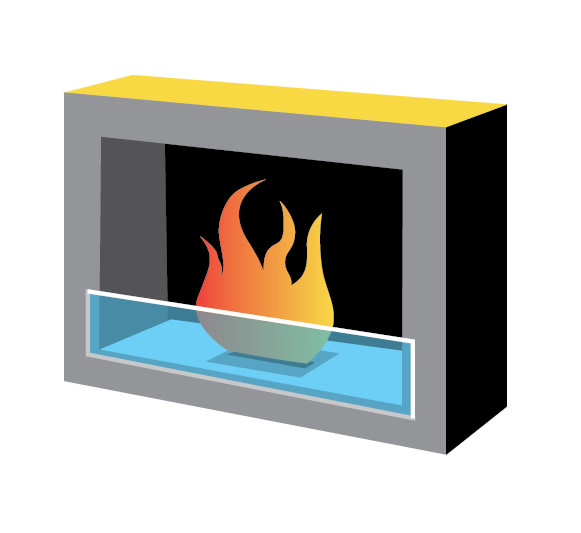
Image: Michael Novak
ECOSMART BIOETHANOL FIREPLACE
“Chimneys suck, literally,” says Aiguier. “When your fireplace is on, 1,000 cubic feet of air per minute rifles out of your house through your chimney; turned off, it’s back-drafting and pumping carcinogens into your house.” Green Hammer installs healthier, chimney-free, alcohol-burning fireplaces, cleaner than a natural gas fireplace. Aiguier refers to the stainless-steel box as a $3,000-plus “glorified fondue kit on your wall” that releases nothing but steam-like moisture.
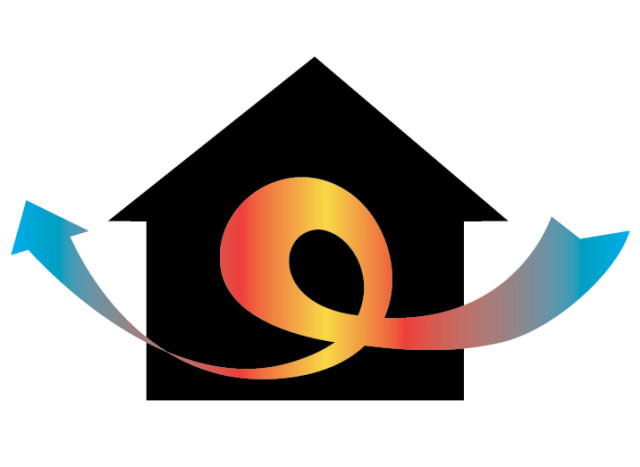
Image: Michael Novak
ZEHNDER HEAT RECOVERY VENTILATION SYSTEM
The heart and lungs of a passive house, this system continuously pumps fresh air in from outside, passes it through a filter, and circulates it through the house, recovering 90 percent of the heat from stale indoor air before it goes outside. The EPA reports that on average a typical, filterless home’s interior air is five times more polluted than outside air. Just save your pennies—retrofitting your existing house with a HRV system can cost around $20,000.
